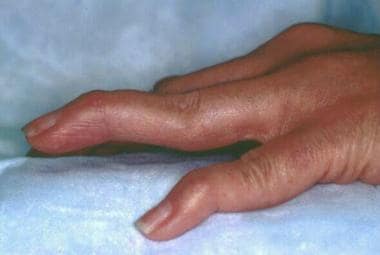Practice Essentials
Rheumatoid arthritis (RA) is a chronic systemic inflammatory disease whose hallmark feature is a persistent symmetric polyarthritis (synovitis) that affects the hands and feet (see the image below). Any joint lined by a synovial membrane may be involved, however, and extra-articular involvement of organs such as the skin, heart, lungs, and eyes can be significant. RA is theorized to develop when a genetically susceptible individual experiences an external trigger (eg, cigarette smoking, infection, or trauma) that triggers an autoimmune reaction.
Rheumatoid arthritis. Rheumatoid changes in the hand. Photograph by David Effron MD, FACEP.
See Rheumatoid Arthritis: In and Out of the Joint, a Critical Images slideshow, to help identify the distinguishing features of RA as well as the signs of extra-articular manifestations of this disfiguring disease.
Signs and symptoms of rheumatoid arthritis
In most patients with RA, onset is insidious, often beginning with fever, malaise, arthralgias, and weakness before progressing to joint inflammation and swelling.
Signs and symptoms of RA may include the following:
Persistent symmetric polyarthritis (synovitis) of hands and feet (hallmark feature)
Progressive articular deterioration
Extra-articular involvement
Difficulty performing activities of daily living (ADLs)
Constitutional symptoms
The physical examination should address the following:
Upper extremities (metacarpophalangeal joints, wrists, elbows, shoulders)
Lower extremities (ankles, feet, knees, hips)
Cervical spine
During the physical examination, it is important to assess the following:
Stiffness
Tenderness
Pain on motion
Swelling
Deformity
Limitation of motion
Extra-articular manifestations
Rheumatoid nodules
Guidelines for evaluation
2010 American College of Rheumatology (ACR)/European League Against Rheumatism (EULAR) classification criteria
2012 ACR disease activity measures
2011 ACR/EULAR definitions of remission
See Presentation for more detail.
Diagnosis
No test results are pathognomonic; instead, the diagnosis is made by using a combination of clinical, laboratory, and imaging features. Potentially useful laboratory studies in suspected RA include the following:
Erythrocyte sedimentation rate
C-reactive protein level
Complete blood count
Rheumatoid factor assay
Antinuclear antibody assay
Anti−cyclic citrullinated peptide and anti−mutated citrullinated vimentin assays
Potentially useful imaging modalities include the following:
Radiography (first choice): Hands, wrists, knees, feet, elbows, shoulders, hips, cervical spine, and other joints as indicated
Magnetic resonance imaging: Primarily cervical spine
Ultrasonography of joints: Joints, as well as tendon sheaths, changes and degree of vascularization of the synovial membrane, and even erosions
Joint aspiration and analysis of synovial fluid may be considered, including the following:
Gram stain
Cell count
Culture
Assessment of overall appearance
See Workup for more detail.
Management of rheumatoid arthritis
Nonpharmacologic, nonsurgical therapies include the following:
Heat and cold therapies
Orthotics and splints
Therapeutic exercise
Occupational therapy
Adaptive equipment
Joint-protection education
Energy-conservation education
Guidelines for pharmacologic therapy
2015 American College of Rheumatology Guideline for the Treatment of Rheumatoid Arthritis
2013 EULAR management guidelines
2012 Agency for Healthcare Research and Quality (AHRQ) recommendations
Nonbiologic disease-modifying antirheumatic drugs (DMARDS) include the following:
Hydroxychloroquine
Azathioprine
Sulfasalazine
Methotrexate
Leflunomide
Cyclosporine
Gold salts
D-penicillamine
Minocycline
Biologic tumor necrosis factor (TNF)–inhibiting DMARDs include the following:
Etanercept
Infliximab
Adalimumab
Certolizumab
Golimumab
Biologic non-TNF DMARDs include the following:
Rituximab
Anakinra
Abatacept
Tocilizumab
Sarilumab
Tofacitinib
Baricitinib
Upadacitinib
Other drugs used therapeutically include the following:
Corticosteroids
Nonsteroidal anti-inflammatory drugs (NSAIDs)
Analgesics
Surgical treatments include the following:
Synovectomy
Tenosynovectomy
Tendon realignment
Reconstructive surgery or arthroplasty
Arthrodesis
See Treatment and Medication for more detail.

